I have traveled to Peru on only one occasion. It was a great trip to Cusco and then down into the Peruvian Amazon. A listing of individual bird species I recorded in Peru is founded at the bottom of this page. The Birds of Peru video portfolio contains the full set of individual species videos. The Birds of Peru photo gallery can be found at this site and a photo gallery entitled Peru which contains more natural history and general interest photographs. I also have a photo gallery at www.ancientpeoples.org which covers several sites in Peru.
NOTES FROM THIS TRIP
Fog in Lima is a hard floor in the Miami Airport. The guy who is sleeping on the floor the next row over is snoring. CNN is blaring and the time is announced over the loud speakers every fifteen minutes. There is a small mouse creeping about.
I started this trip early yesterday morning and I have gotten as far as Miami but Lima has had fog every morning this week and the flights from Miami are delayed. Scheduled for 11:00 p.m., perhaps we will leave at 6:00 a.m.
The American Airlines staff was kind enough to bring us blankets. Future passengers are curled up where ever they felt safe and comfortable. The blankets are disappearing now and the floors are clearing as passengers drift in from other parts of the terminal.
The current local time is 5:00 a.m.
We start to board at 6:15 and depart at 7:30. Napping on the way, I am tired. I had not realized that the dry country extends north of Lima into Columbia. A geography lesson I would have missed if Lima had not had fog.
Lima: The LAN Peru people were helpful in getting me rebooked to Cusco. I was able to reach the Amazonia Lodge booking agent in Cusco and everything is back on track with what will be only one lost day. I am tired, grimy, sweaty - well, you get the picture, uninspired.
The old part of Cusco
Cusco: I arrive in Cusco at about 4 p.m. and am met by my driver and the Amazonia agent.
The driver is named Raul, he speaks about as much English as I do Spanish but we have a good time as we drive out of Cusco and head for the mountains.
We wind our way along the edge of mountains and stop in a small valley for a box lunch. Raul says that we will reach Cock-of-the-Rock lodge at 11:00 p.m. I hope he is wrong, I am exhausted - I need a lot of sleep and the last two days I have managed about 4 hours total.
The scenery is beautiful, wide open spaces with little growing very high. Then it gets dark and the scenery is still beautiful, there is a full moon and the landscape takes on a gentle glow. In the moonlight, leaves are as bright as the whitest flower.
Along the way we see two possum like creatures, possibly Philander opossum and a Nightjar (possibly Ladder-tailed Nightjar).
The road is one lane most of the time, with some turnouts - we meet cargo trucks and buses (“large cars” as Raul says). Occasionally there is rock fall and small slides, we pass large sections of road which have slid in the past.
We cross the passes ( I get a headache and notice the difference in breathing -- all that from only 11,000 feet) and start down toward the Amazon.
Mud and stream fords become more prevalent, we go through two tunnels hewn from the rock in just the right size for the trucks and buses, narrow and tall.
A bug hangs on the windshield, something that looks like a cross between a butterfly and a wasp -- I wonder if it will make it until eleven. We drive through a waterfall (“carwash” says Raul) -- the bug doesn’t make it.
With all the flying, Miami, and almost seven hours on the bouncy dirt/rock road, I can’t wait until eleven. The streams we ford are shallow and not very wide, with nice gravel bottoms, but as you come up on them they look like black windows to the center of the earth. Eleven comes and goes, Raul thinks another half hour. I feel like a zombie.
Then, there it is is! A truck! Half tilted on its side after a part of the road collapsed. It takes up the road, there is no way around, the crowd (from two buses behind) has found a pick and shovel and they are trying to dig the truck out.
Raul says that is is only a mile or so to the lodge so Raul grabs my bag and I grab the equipment and off we go -- the road is pretty light except where the trees block the moonlight. Raul is setting a pace. I am still wearing my sandals and hope I don’t turn an ankle on the odd rock in the shade -- but quickly forget the thought as I mutter something about being a walking zombie.
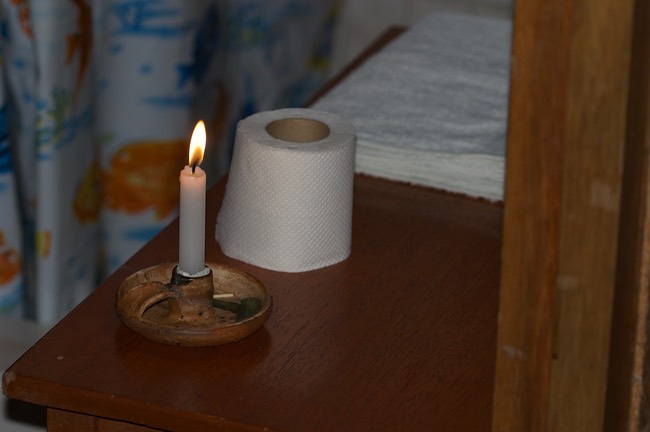
The odd rock. My knees grind into the road followed by my hands. The tripod flies away, the camera pack comes over my head and does its own header into the ground. I am laying on my back in a tangle of equipment.
“No Raul, don’t touch me” don’t try to clean up the mess -- I need to sort my head out. I’m tired and I’m hurt but I can walk. Off we go again, Raul says we should walk slower.
We reach Cock-of-the-Rock and roust a staffer out of bed to get our rooms. It is 1:30 a.m. No electricity here but lots of candles a good bed and and a bathroom.
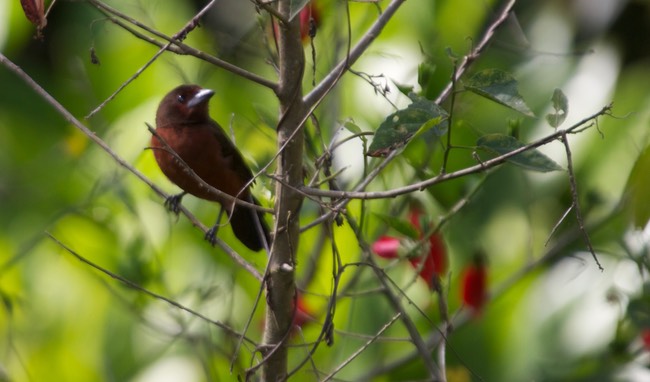
The alarm goes off at 5:30, I sleep until 6:00. My knees are gouged and cut but my hands and head are fine. The video camera gives me trouble today - I can get it to work but it takes some tinkering. “Check the lens” it says, I take the lens off, put the lens on, and that generally works for a while. Video cameras must not like headers on moonlit nights in Peru.
Shot an hour of tape today -- that would normally be very good but I am not sure how the hummingbird material will be, given the antics of the camera.
Good tape, I think, of Andean Cock-of-the-Rock, Capuchin Monkey, South American Coati, Agouti, and some tanagers (Silver-beaked Tanager to the right). But mostly trying to get hummingbirds, they are a pain.
I work by candlelight in the evening and look forward to more Cock-of-the-Rock and a full nights sleep.
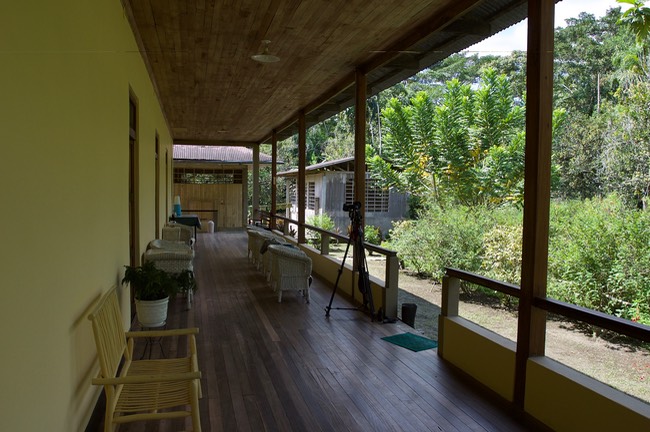
Up at 5:00 to go to the Cock-of-the-Rock lek and an Amazonian Umbrellabird is thrown in for extra effect. Spent most of the morning taping hummingbirds and then we were off.
The road is much better in the light. We leave at 10:00 and arrive at the boat area at 3:00, having taken a leisurely drive, stopping along the way to tape Bat Falcon and few other species.
On the way we drove through some very poor villages. The incredible economic divide between these people and the average North American is so terribly discouraging.
We take the boat down river to the Amazonia Lodge boat landing. A walk through the forest and we are at the lodge, where a cool limeade, a restful porch (photo right), and a shower await.
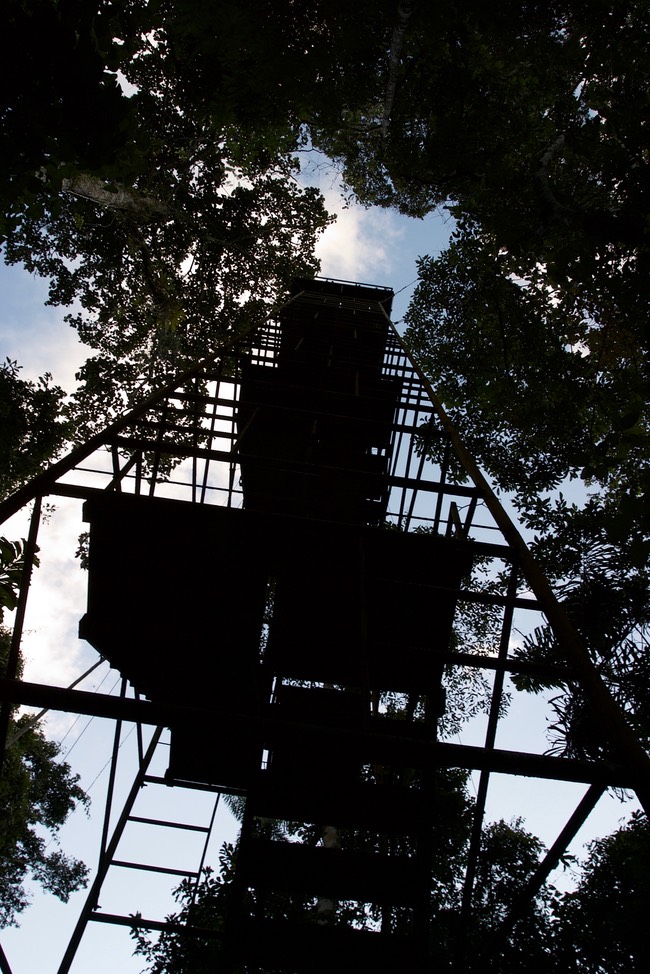
The following day I have the “scratching of the elbows”, it doesn’t take long for the biting things to find my elbows. And my hands, those poor things that are working the camera and taking a biting all the time. Luckily the biting things seem to have been at the Cock-of-the-Rock, not here at Amazonia.
Instead of growing more tolerant of the bites over the years my body seems to be more reactive -- my hands and arms are puffy. The bites I hate the most are the ones that blister - spider bites, I don’t care for spider bites either.
This afternoon, I trekked up the hill with all of my equipment, stopping frequently along the way. My destination was the Amazonia Lodge Tower, a well constructed tower (photo right) which reaches into the upper canopy. The sweat flies, they don’t bite, join me at the top, boy am I out of shape.
Food - good. Things to remember, always try to remember some food from a trip. From here:
1. Mate de Coca - tea made from the leaves of coca, it is quite good. At the breakfast “bars” in Cusco and many other places you find dried Coca leaves in a bowl to use for tea. It is a mild herbal tea that refreshes but does not have the strength of caffeine. On the way to the Amazon we saw coca fields (photo below right) and the locals laying coca leaves out to dry. Blue tarps with a layer of green. In the USA we have a drug problem -- our solution: get these people to change their ancient culture and ways, seems odd doesn’t it?
2. Cantaloupe with the liquid yogurt (twice as thick as good buttermilk) they have here -- indeed, pourable yogurt is good stuff.
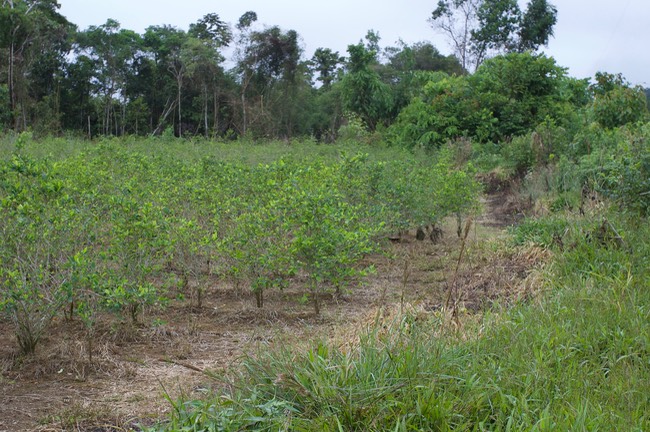
3. Maybe the best chicken soup (almost a stew) I have ever had.
4. Omelets with assorted things, all of which seem to have different tastes than in the north.
5. Essence of cafe, a super strong espresso or coffee extract which you mix with hot water -- way better than Nescafe. For years coffee has been poor in South America, all of the good stuff is exported -- maybe there is hope.
6. Yucca and the many species and varieties of potatoes. The mass market of the north is greatly deprived.
7. Fresh fruit generally!!!! Not the hard tasteless stuff you find in American supermarkets.
Food is good in Peru, well worth the effort -- and you don’t even have to try guinea pig, if you don’t want to.
I’m sitting on the porch, it is about 5 p.m.. I have just taken a shower and got into some almost clean clothes. I am sitting on the veranda looking at hummingbirds in the yard of the lodge. It is getting dusk. This is the land of days that go from 6 to 6 [and so do the nights, by the way] year round. The weather has been sunny with temperatures (I guess) from 75 to 85 degrees F.
Today I paid a lot of attention to the sounds of the jungle, the rapping of a large woodpecker, Oropendolas, and Spider-monkeys.
This afternoon a large troop of Squirrel-monkeys passed through me. In dense growth I could hear them move toward me but could not see them except for a few moments when they crossed the trail, above me and on either side of me on the ground -- the troop went through me.
A Jacamar and a Tinamou are calling. Taping in the jungle is hard, it is difficult to find the object in all the tangle, the lighting is always bad, etc. etc. When you get the image you know its an accomplishment though.
All of this lodge was flooded, water was so high that it was in the elevated rooms, they have been working very hard to get it back into shape and are doing a fantastic job.
Raul has shown up and we have worked out a deal where he is going to go with me into the jungle and show me Trumpetero tomorrow. To see Pale-winged Trumpeters would be an exciting, and rare, event.

I have looked for Hoatzin (Photo right) a number of times and seen them only once in my trips to South America. This morning I walked 150 meters from my bed and spent several hours doing video of them. Quite remarkable.
At the moment, I have just finished a large lunch and I’m sitting on the porch thinking about a nap.
After the Hoatzin, the morning was lousy for video. Raul and I hiked up the hill, thick growth and no real good views. Some birds of note include Scarlet Macaw and a group of five Pale-winged Trumpeters. No video of the Trumpeters. We tried to follow them through the jungle but the vines played havoc with the tripod and camera. Pale-winged Trumpeters - video or not, a great morning.
This afternoon has been hot and still. I don’t deal with hot and still well. What is this pipe-dream I have about an adobe home along a desert stream in the mountains of Arizona (USA)? It would probably turn out to be terrible. (As I post this material to this website in July 2017, I live in an adobe house along a stream in the Black Range of New Mexico - just got the state wrong - and it is wonderful.)
Santiago is the patriarch here. Other than patriarchal duties like running the place he spends time with his grandkids and chasing the Oropendolas away from the feeders and the fruit trees.
I woke to rain and Pale-legged Hornero, Cinerous Tinamou, and a giant Walking Stick. Not a bad combination, all in all.
Raul and I headed into the jungle after breakfast, under the threat of rain which never materialized. Almost immediately I taped Hoatzin and two woodpecker species. Another sweaty workout along the trail with excellent views of Woolly Monkey, a large troop in the canopy which either broke a lot of branches accidentally or were being pretty aggressive. At least once I scurried down the trail quickly (leaving the camera behind) when large branches came crashing through the canopy. Raul thought that was quite funny, no doubt he is not as prone to being hit on the head as I am. Later we saw another group of Pale-winged Trumpeters (still no video) and a tapir track on the trail.
In the afternoon, a pretty young woman walked out of the jungle. She was studying to be a guide and spoke English. We compared notes on birds (she had just seen a group of Peccary) and then she walked off into the jungle. Sometimes things like that happen -- I feel like I am in some B-grade movie. (From her perspective: I was doing my research at Amazonia Lodge, while walking on the trail I met an old tourist - we talked about birds for a bit and then I went on my way.) Bet the event did not make it into her blog!
We have been invaded by termite swarms which are attracted to the lights (one night and then no more). They run the generator here from 6 to 9. It is great to have a little light and be able to charge batteries. (I’m not that tired at the end of the day - but I have never heard the generator go off.)
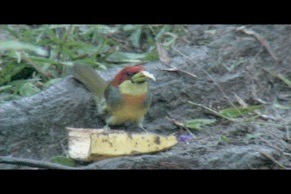
Woke to rain, Tinamous, Horneros, and Lemon-throated Barbet (frame grab from video to the right). I have settled into the laziest of all possible lifestyles. I wake at six, look at birds, breakfast at 7, hit the trail at 7:30 and come in between 12:00 and 1:00 (a lot of sweat during this period). Lunch at 1, take a siesta until 3. Maybe hike and maybe sit on the porch. Dinner at 7, bed by 8:30.
Up to the tower this morning for a second time. Easier, but still drenched in sweat. Not much bird activity but lots of sweat bees - everywhere, driving me crazy. In my ears, in my eyes, in my nose. Made it impossible to tape.

The botany here is incredible, lots of flowers, and various shaped leaves. The fauna ain’t bad either - today I have concentrated on brightly colored butterflies.
Rain all morning. Blue-throated Piping-Guan, Black-capped Donacobius, and a Roadside Hawk added to the video list. (The Rufous-crested Coquette shown here stayed near the yard all day.)
People who work at the Dallas, Texas (USA) Zoo have come and gone. Zoo people have an interesting perspective on nature -- one that I found vaguely disturbing, although I am not able to point to a specific issue. They voiced a lot of concern about whether it is safe for Americans to travel these days but I did not sense that they thought that the actions of Americans had in any way influenced that fact.
I spent a lot of time working the hummingbirds, there are a number of species which work the flowers just off of the veranda. It would be easy video if they would stay put for a moment.
On the last full day of my stay, Santiago brought me a pretty moth cupped in his hands. When he opened his hands, the moth flew off -- about ten feet, before it was snagged by a Silver-beaked Tanager.
Back through the jungle to the boat landing, a ride up river under an overcast sky (photo below), a long drive (not much time for birding), and I am back in Cusco in southern Peru.
The new city of Cusco is Latin American modern with a lot of diesel smoke and swirling traffic. The old city of Cusco is a wonderful place. I had planned a couple days in Machu Picchu, unlike all of the other tourists (who often spend only part of a day there), but cancelled so I could spend several days in Cusco. Machu Picchui and the rest of Peru can wait until the next trip.
The streets of old Cusco, Peru are narrow cobblestone lanes barely wide enough for the fleets of small taxis which zip about. Except around the central square, the sidewalks range from none to those which are no more than two feet wide. When I met someone on these sidewalks I would have to scrunch up next to the wall while the other person squeezed by or stepped off into the street - taxis allowing.
The lower walls of buildings are often from the Inca era (photo below) with colonial structures built on top. The innards have been updated with electricity and plumbing, making Cusco extremely picturesque and very livable.
Doors line the street, only the width of the narrow sidewalk from the cobblestone roads. As I walked along the sidewalk I would often have to step into a doorway to let someone pass. It might be a doorway to a little grocery, sometimes a small restaurant, a machine shop perhaps, or an alleyway. No neon signs to hide the mystery, I had to venture through the doors to see the inner value and absorb the experience.
While at Amazonia Lodge, several people recommended that I visit the Inca site named Sacsayhuaman, which is located near Cusco, Peru. The name has been Anglicized to “Sexy Woman” and is generally known in tourist circles by that name.
During my stay in Cusco, Raul joined me for a day of “site seeing”. We started high on the hills overlooking Cusco at the “Sacred Valley” site and ventured down the valleys to Sacsayhuaman (photo above). The day was beautiful, the flowers were bright, the occasional sheep herd moved out of the way as we walked cross country. Raul, Pedro (a local guide I met the day before), Pedro’s brother (who wanted to work on his English), and I walked along discussing ruins, the Spanish invasion, the plants, and the birds. Along the way there were numerous Andean Flickers and various hummingbirds.
Sacsayhuaman is a very impressive and large site. The stones are large, well formed, and well fit. The pageantry here must have been incredible. Walking the rest of the way into Cusco, we stopped for mid-afternoon lunch and listened to live local music, a very enjoyable day with friends which I will long recall.
As I wandered about southeastern Peru I was continually impressed by the bright colors of the local people’s clothing and by their caution when encountering a person with a camera. I concluded they had had enough with being artistic objects for photographers. This was especially true in the highlands.
In Cusco, I had a different experience. There, a number of people had turned local color into a livelihood. The gentleman pictured above offered me the opportunity to take his photograph for 1 Sol per shot (about thirty US cents). The photograph below is of a weaver in one of the squares in Cusco.
Later I had to pay off a couple of cute kids who extorted me by standing in front of me whenever I stopped to take a shot -- I have several shots with the boy’s baseball hat in the center of the bottom of the frame.
All in all, a very strange feeling but one I believe that I could get use to -- they have figured out “modeling”. On the flight home, I read an article by a prize winning photographer who wrote about how important it was to get a quick shot, before the subject knew what was happening -- I found that concept utterly repulsive.
I don’t consider myself to be much of a butterfly person, but you can’t help but run into the beautiful little buggers when you are birding.
There are many wonderful sites for butterflies, the Amazon is particularly good and there is one fail safe technique to finding butterflies (other than hanging around flowers and wet margins [of anything]). Sweat. That is the answer. Sweat. Want to find butterflies? Get yourself out of shape and sweat a lot.
This photograph below was taken in Peru during May, you guessed it -- it’s a walking stick and the spot the butterfly is perched at was a spot a hand held the stick, a sweaty hand. There is nothing better for butterflies than working the jungle all day and sitting down for a rest. The butterflies, many colored, many shaped butterflies appear from nowhere -- then you can’t rest because you have to take photos and video -- seems circular.
VIDEO OF INDIVIDUAL BIRD SPECIES
LISTING FOR PERU
Coquette, Festive (second clip)
Hoatzin (second clip)